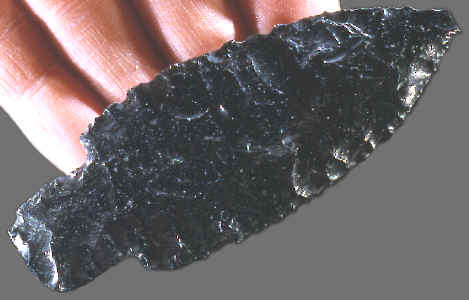|
WINDUST POINT
This Windust point was found in 1989 under the
right side of the cranium of the "Buhl Woman" burial. The Buhl
site is located in Twin Falls County, Idaho about 1.5 miles (2.5 km)
north of the town of Buhl. The initial discovery was made by gravel quarry workers who pulled a human
femur out of the screen of a rock crusher. The actually
burial site was quickly located after the initial discovery. Bone
samples taken from the burial produced a radio carbon date of 10,675 +
95 years before present. Study of the teeth and bones suggest that the
"Buhl Woman" was between 17 and 21 years old when she died.
No genetic testing was done but the skull's morphology was similar to
both American Indian and East Asian populations.
There were four artifacts and one badger baculum bone found with the
Buhl skeleton. Besides the Windust point, the picture above shows casts
of the three other artifacts that were found. The bone needle was
restored before it was cast. The black line indicates where it was
originally broken. It measured 1 1/4 inches (3.1 cm) long before it was
restored. It also measured 2 mm in diameter and the eye measured .8 mm
in diameter. Microscopic examination suggests that the eye was not
drilled but it was formed by gouging with a hand-held perforator. The
other two bone pieces have been described as fragments belonging to
possibly a single awl or pin. The broken segment on the left has 11
engraved lines cut along the edges. |
|
"REFERENCES"
1991,
Perino, Gregory, "Selected Preforms, Points and Knives of the North
American Indians," Vol. 2, page 248. |

